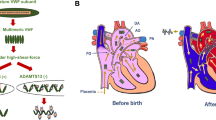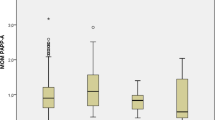Abstract
Objective
In this study, we sought to characterize the tumor necrosis factor α (TNFα) baseline operational capacity in mature fetuses and their mothers prior to the onset of labor.
Materials and Methods
We used an experimental pregnant nonhuman primate model to measure the plasma concentration of TNFα, TNF transmembrane receptor I (TNFRI), and TNFRII with validated enzyme-linked immunosorbent assays. Coefficients of correlations between the maternal and the fetal values and the soluble TNFα, TNFRI, or TNFRII concentrations and ratios were calculated.
Results
The TNFα/TNFRI ratio was 3 times lower in fetal circulation than in maternal circulation. No correlations were noted between the maternal and the fetal TNFα, TNFRI, or TNFRII plasma concentrations.
Conclusions
These findings suggest that the fetal and maternal baseline circulatory operational capacities of TNFα are independent of each other and tuned differently. This differential regulation of TNFα in fetal and maternal circulation at the end of pregnancy may be guided to protect the fetus from the systemic inflammatory response that is essential for the mechanisms of labor to proceed in the mother.
Similar content being viewed by others
References
Bazzoni F, Beutler B. The tumor necrosis factor ligand and receptor families. N Engl J Med. 1996; 334(26):1717–1725.
Ruddle NH. Tumor necrosis factor (TNF-alpha) and lymphotoxin (TNF-beta). Curr Opin Immunol. 1992;4(3):327–332.
Vanden Berghe W, Vermeulen L, De Wilde G, De Bosscher K, Boone E, Haegeman G. Signal transduction by tumor necrosis factor and gene regulation of the inflammatory cytokine interleukin-6. Biochem Pharmacol. 2000;60(8):1185–1195.
Carswell EA, Old LJ, Kassel RL, Green S, Fiore N, Williamson B. An endotoxin-induced serum factor that causes necrosis of tumors. Proc Natl Acad Sci U S A. 1975;72(9):3666–3670.
Beutler B, Greenwald D, Hulmes JD, et al. Identity of tumour necrosis factor and the macrophage-secreted factor cachectin. Nature. 1985;316(6028):552–554.
Vilcek J, Lee TH. Tumor necrosis factor. New insights into the molecular mechanism of its multiple actions. J Biol Chem. 1991;266(12):7313.
Davis JM, Narachi MA, Alton NK, Arakawa T. Structure of human tumor necrosis factor alpha derived from recombinant DNA. Biochemistry. 1987;26(5):1322–1326.
Jones E, Stuart D, Walker N. Structure of tumour necrosis factor. Nature. 1989;338(6212):225–228.
Calleja-Agius J, Muttukrishna S, Jauniaux E. The role of tumor necrosis factor-receptors in pregnancy with normal and adverse outcome. Int J Interferon Cytokine Mediator Res. 2012;4:1–15.
Dembic Z, Loetscher H, Gubler U, et al. Two human TNF receptors have similar extracellular, but distinct intracellular, domain sequences. Cytokine. 1990;2(4):231–237.
Aderka D, Engelmann H, Shemer-Avni Y, et al Variation in serum levels of the soluble TNF receptors among healthy individuals. Lymphokine Cytokine Res. 1992;11(3):157–159.
Porteu F, Nathan C. Shedding of tumor necrosis factor receptors by activated human neutrophils. J Exp Med. 1990;172(2): 599–607.
Seckinger P, Isaaz S, Dayer JM. Purification and biologic characterization of a specific tumor necrosis factor alpha inhibitor. J Biol Chem. 1989;264(20):11966–11973.
Engelmann H, Novick D, Wallach D. Two tumor necrosis factor-binding proteins purified from human urine. Evidence for immunological cross-reactivity with cell surface tumor necrosis factor receptors. J Biol Chem. 1990;265(3):1531–1536.
Olsson I, Lantz M, Nilsson E, et al Isolation and characterization of a tumor necrosis factor binding protein from urine. Eur J Haematol. 1989;42(3):270–275.
Haider S, Knöfler M. Human tumour necrosis factor: physiological and pathological roles in placenta and endometrium. Placenta. 2009;30(2):111–123.
Chen HL, Yang YP, Hu XL, Yelavarthi KK, Fishback JL, Hunt JS. Tumor necrosis factor alpha mRNA and protein are present in human placental and uterine cells at early and late stages of gestation. Am J Pathol. 1991;139(2):327–335.
Harris LK, Keogh RJ, Wareing M, et al Invasive trophoblasts stimulate vascular smooth muscle cell apoptosis by a fas ligand-dependent mechanism. Am J Pathol. 2006;169(5):1863–1874.
Keogh RJ, Harris LK, Freeman A, et al Fetal-derived trophoblast use the apoptotic cytokine tumor necrosis factor-alpha-related apoptosis-inducing ligand to induce smooth muscle cell death. Circ Res. 2007;100(6):834–841.
Witkin SS, Liu HC, Davis OK, Rosenwaks Z. Tumor necrosis factor is present in maternal sera and embryo culture fluids during in vitro fertilization. J Reprod Immunol. 1991;19(1):85–93.
Yang Y, Yelavarthi KK, Chen HL, Pace JL, Terranova PF, Hunt JS. Molecular, biochemical, and functional characteristics of tumor necrosis factor-alpha produced by human placental cytotrophoblastic cells. J Immunol. 1993;150(12): 5614–5624.
King A, Jokhi PP, Smith SK, Sharkey AM, Loke YW. Screening for cytokine mRNA in human villous and extravillous trophoblasts using the reverse-transcriptase polymerase chain reaction (RT-PCR). Cytokine. 1995;7(4):364–371.
Yelavarthi KK, Hunt JS. Analysis of p60 and p80 tumor necrosis factor-alpha receptor messenger RNA and protein in human placentas. Am J Pathol. 1993;143(4):1131–1141.
Knofler M, Mosl B, Bauer S, Griesinger G, Husslein P. TNF-alpha/TNFRI in primary and immortalized first trimester cytotrophoblasts. Placenta. 2000;21(5–6):525–535.
Boyle JJ, Weissberg PL, Bennett MR. Tumor necrosis factor-alpha promotes macrophage-induced vascular smooth muscle cell apoptosis by direct and autocrine mechanisms. Arterioscler Thromb Vasc Biol. 2003;23(9):1553–1558.
Santolaya-Forgas J, Van Hook J, Edwin S, et al. Maternal plasma and celomic fluid concentration of TNFα, sTNFR-1, sTNFR-2 and RANTES in extraembryonic celomic fluid in pregnant baboons. Reprod Sci. 2006;13 suppl:(SGI Filename: 950579).
Austgulen R, Liabakk NB, Brockhaus M, Espevik T. Soluble TNF receptors in amniotic fluid and in urine from pregnant women. J Reprod Immunol. 1992;22(2):105–16.
Brown MD, Feairheller DL, Thakkar S, Veerabhadrappa P, Park J-Y. Racial differences in tumor necrosis factor-α-induced endothelial microparticles and interleukin-6 production. Vasc Health Risk Manag. 2011:7 541–550.
Stonek F, Bentz EK, Hafner E, et al. A tumor necrosis factor-α promoter polymorphism and pregnancy complications: results of a prospective cohort study in 1652 pregnant women. Reprod Sci. 2007;14(5):425–429.
Lambin S, van Bree R, Vergote I, Verhaeghe J. Chronic tumor necrosis factor-α infusion in gravid C57Bl6/J mice accelerates adipose tissue development in female offspring. J Soc Gynecol Investig. 2006;13(8):558–565.
Gropper MA. Evidence-based management of critically ill patients: analysis and implementation. Anesth Analg. 2004; 99(2):566–572.
Tartaglia LA, Goeddel DV. Two TNF receptors. Immunol Today. 1992;13(5):151–153.
Bone RC, Balk RA, Cerra FB, et al. Definitions for sepsis and organ failure and guidelines for the use of innovative therapies in sepsis. Chest. 2009;136(5 Suppl):e28.
Naworth PP, Stern DM. Modulation of endothelial cell hemostatic properties by tumor necrosis factor. J Exp Med. 1986;163(3): 740–745.
Russell JA. Management of sepsis. N Engl J Med. 2006;355(16): 1699–1713.
Kerschensteiner M, Meinl E, Hohlfeld R. Neuro-immune crosstalk in CNS diseases. Neuroscience. 2009;158(3): 1122–1132.
Van Zee KJ, Kohno T, Fischer E, Rock CS, Moldawer LL, Lowry SF. Tumor necrosis factor soluble receptors circulate during experimental and clinical inflammation and can protect against excessive tumor necrosis factor alpha in vitro and in vivo. Proc Natl Acad Sci U S A. 1992;89(11):4845–4849.
Girardin E, Roux-Lombard P, Grau GE, Suter P, Gallati H, Dayer JM. Imbalance between tumour necrosis factor-alpha and soluble TNF receptor concentrations in severe meningococcaemia. The J5 Study Group. Immunology. 1992;76(1):20–23.
Spinas GA, Keller U, Brockhaus M. Release of soluble receptors for tumor necrosis factor (TNF) in relation to circulating TNF during experimental endotoxinemia. J Clin Invest. 1992;90(2):533–536.
Elliott MJ, Maini RN, Feldmann M, et al. Randomised double-blind comparison of chimeric monoclonal antibody to tumour necrosis factor alpha (cA2) versus placebo in rheumatoid arthritis. Lancet. 1994;344(8930):1105–1110.
Matsuda T, Nakajima T, Hattori S, et al. Necrotizing funisitis: clinical significance and association with chronic lung disease in premature infants. Am J Obstet Gynecol. 1997;177(6): 1402–1407.
Redline RW, Wilson-Costello D, Hack M. Placental and other perinatal risk factors for chronic lung disease in very low birth weight infants. Pediatr Res. 2002;52(5):713–719.
Santolaya-Forgas J, Mehta SH, Castracane VD. A study to determine if acute maternal fetal hyperglycemia/insulinemia induces leptin production during pregnancy. Horm Metab Res. 2006;38(9):598–602.
Santolaya-Forgas J, Romero R, Mehendale R. The effect of continuous morphine administration on maternal plasma oxytocin concentration and uterine contractions after open fetal surgery. J Matern Fetal Neonatal Med. 2006;19(4):231–232.
Oberyszyn TM. Inflammation and wound healing. Front Biosci. 2007;12:2993–2999.
Kniss DA, Zimmerman PD, Garver CL, Fertel RH. Interleukin-1 receptor antagonist blocks interleukin-1-induced expression of cyclooxygenase-2 in endometrium. Am J Obstet Gynecol. 1997; 177(3):559–567.
Imseis HM, Zimmerman PD, Samuels P, Kniss DA. Tumour necrosis factor-alpha induces cyclo-oxygenase-2 gene expression in first trimester trophoblasts: suppression by glucocorticoids and NSAIDs. Placenta. 1997;18(7):521–526.
Pomini F, Caruso A, Challis JR. Interleukin-10 modifies the effects of interleukin-1beta and tumor necrosis factor-alpha on the activity and expression of prostaglandin H synthase-2 and the NAD+-dependent 15-hydroxyprostaglandin dehydrogenase in cultured term human villous trophoblast and chorion trophoblast cells. J Clin Endocrinol Metab. 1999;84:4645–4651.
Christiaens I, Zaragoza DB, Guilbert L, Robertson SA, Mitchell BF, Olson DM. Inflammatory processes in preterm and term parturition. J Reprod Immunol. 2008;79(1):50–57.
Ulug U, Goldman S, Ben-Shlomo I, Shalev E. Matrix metalloproteinase (MMP)-2 and MMP-9 and their inhibitor, TIMP-1, in human term decidua and fetal membranes: the effect of prostaglandin F(2alpha) and indomethacin. Mol Hum Reprod. 2001;7(12):1187–1193.
Dudley DJ. Immunoendocrinology of preterm labor: the link between corticotropin-releasing hormone and inflammation. Am J Obstet Gynecol. 1999;180(1 Pt 3):S251–S256.
Kossintseva I, Wong S, Johnstone E, Guilbert L, Olson DM, Mitchell BF. Proinflammatory cytokines inhibit human placental 11beta-hydroxysteroid dehydrogenase type 2 activity through Ca2+ and cAMP pathways. Am J Physiol Endocrinol Metab. 2006;290(2):E282-E288.
Lahra MM, Beeby PJ, Jeffery HE. Intrauterine inflammation, neonatal sepsis, and chronic lung disease: a 13-year hospital cohort study. Pediatrics. 2009;123(5):1314–1319.
Redline RW. Inflammatory responses in the placenta and umbilical cord. Semin Fetal Neonatal Med. 2006;11(5):296–301.
Lappen JR, Keene M, Lore M, Grobman WA, Gossett DR. Existing models fail to predict sepsis in an obstetric population with intrauterine infection. Am J Obstet Gynecol. 2010;203(6): 573.e1–5.
Mittendorf R, Roizen N, Moawad A, Khoshnood B, Lee KS. Association between cerebral palsy and coagulase-negative staphylococci. Lancet. 1999;354(9193):1875–1876.
Perry VH, Cunningham C, Holmes C. Systemic infections and inflammation affect chronic neurodegeneration. Nat Rev Immunol. 2007;7(2):161–167.
Kane SV, Acquah LA. Placental transport of immunoglobulins: a clinical review for gastroenterologists who prescribe therapeutic monoclonal antibodies to women during conception and pregnancy. Am J Gastroenterol. 2009;104(1):228–233.
Clowse ME. The use of anti-TNFα medications for rheumatologic disease in pregnancy. Int J Women’s Health. 2010;2:199–209.
Author information
Authors and Affiliations
Corresponding author
Rights and permissions
About this article
Cite this article
Santolaya, J.L., Kugler, L., Francois, L. et al. Baseline TNFα Operational Capacity in Fetal and Maternal Circulation Prior to the Onset of Labor: “Tuned for Different Purposes”. Reprod. Sci. 20, 838–844 (2013). https://doi.org/10.1177/1933719112468953
Published:
Issue Date:
DOI: https://doi.org/10.1177/1933719112468953




